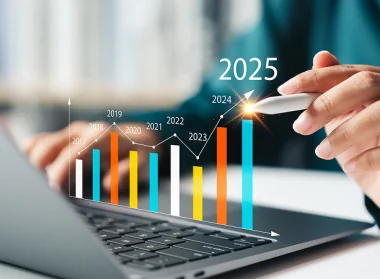Understanding how to use tools like predictive analysis is essential for any business with plans to survive, thrive, and grow in the future by making smart decisions in the present.
Traditional models of financial analysis excelled at describing existing patterns within historical spend, but the utility of these models had a rather short shelf life.
With more companies embracing digital transformation, using emerging technologies like deep data analytics to perform trend analysis helps procurement organizations create more accurate and complete forecasts for the future, and adjust their strategic sourcing and overall spend management strategies accordingly.
But before you can take advantage of trend analysis, you need to understand what it is and where it fits within the spend forecasting process.
Mining Patterns for Insight: What is Trend Analysis?
Part of a larger overall process called spend forecasting—which aims to provide optimal decision making for strategic sourcing based on insights gleaned from patterns within historical data, analysis of current conditions, and predictive analytics—trend analysis tries to answer the question of “What’s next?” for a specific period of time, whether it’s months, quarters, or years in the future.
A type of regression analysis, trend analysis is perhaps most famously used in financial and technical analysis, although it’s also commonly used in inventory management.
Its purpose is to identify trends for specific time periods, examine and analyze those trends for patterns, and use the intelligence collected to create predictions of future movement within systems such as financial markets or an organization’s internal financial and operational processes.
The more data you have available, the more effectively you can forecast along a trend line.
When examining the stock market and overall economic conditions, trend analysis can help you identify one of three types of trends:
- Uptrends (markets, stock prices, and asset prices increase over a given amount of time)
- Also known as a “bull market” when analyzing economic conditions.
- Marked by favorable current conditions and predicted growth.
- Investors are eager to “catch the wave” and invest.
- Downtrends (markets and asset prices decrease over a given amount of time)
- Also known as a “bear market” when analyzing economic conditions.
- May indicate a contraction of the stock market and/or economy as a whole.
- Marked by unfavorable market conditions and predicted stagnation or contraction.
- Investors become more conservative.
- Sideways trends/horizontal line trends (markets and asset prices are flat, and difficult to track, encouraging changes that promote an uptrend)
- Creates uncertainty for shareholders and investors.
- Makes accurate and strategic decision making much more difficult.
- Encourages positive and corrective change to encourage a “bull market run.”
From Stock Markets to Strategic Sourcing
These concepts can be readily adapted to internal accounting systems and operational workflows.
Turned inward, trend analysis can be used to examine an organization’s profit and loss statement (income statement) and other financial records for one or more time periods.
The team performing trend analysis tries to identify inaccuracies in financial statements, establish and analyze overall growth, and identify patterns as well as inconsistencies that may indicate underlying issues.
Applied to internal processes, trend analysis highlights the costs of doing business, recurrent spend and performance patterns, and potential areas where value and savings can be recovered or even enhanced through a trend reversal.
For example, unusual expenditures, erratic or declining sales figures, and unsubstantiated expense report figures can all provide insights into areas in need of improvement, allowing the team to seek out new suppliers, streamline their internal processes to improve transparency and accountability, and automate their procure-to-pay (P2P) workflows to lower costs and boost value by eliminating fraud and rogue spend, respectively.
The true value of trend analysis is in its powers of prognostication; however, the predictions made are only as reliable as the quality and quantity of the data available (whether it’s spend patterns, market data, past performance data, etc.), and the tools used to make such predictions.
Modern analytical tools (such as the data management and analysis tools built into PLANERGY) make it possible to collect, organize, and analyze massive data sets in real time, vastly improving the accuracy, speed, and useful life of insights and forecasts.
Applied to internal processes, trend analysis highlights the costs of doing business, recurrent spend and performance patterns, and potential areas where value and savings can be recovered or even enhanced through a trend reversal.
How Trend Analysis Fits into Spend Forecasting
To add predictive power to your spend data analysis and management, trend analysis relies on three specific types of financial analysis and projection:
1. Demand Forecasting
Identifying the sweet spot between supply and demand to get the best possible price is essential for all businesses, whether they’re buying raw materials for production or the goods and services that support operations.
The purpose of demand forecasting is to analyze multiple data sources, including stock market trends, industry intelligence, and external events such as regulatory changes, global economic disruptions, and natural disasters to determine their impact on demand and the ways in which the unit price for any purchase will be affected over a given amount of time.
Knowing whether demand will grow, fall, or remain steady makes it easier to make sourcing decisions that help you guard against current and future expenses while also creating value through supply chain optimization and reducing total cost of ownership (TCO).
Using demand forecasting:
- Creates immediate savings and improves cash flow management by allowing organizations to pay today’s prices for materials that will still be useful at a later date but are predicted to cost more..
- Helps teams balance actual need against future demand and price fluctuations. Stocking up on essential commodities for production that are used in large amounts on a regular basis is a smart move, for example—particularly if you can provide such materials to your suppliers and slash your supply chain costs at that level.
But if, for example, analysis reveals costs for a specific (and expensive) component used in your production line are expected to quadruple over five years, it pays to consider how that component is used. If, for example, it lasts for up to a decade with normal operations, it’s smart to invest in a spare or two at today’s prices, but not to buy a dozen, since that capital could be put to much better use for investment or innovation over the next five years—and better still, you won’t be stuck with paying to store and maintain a pile of expensive components that could become useless if technology or your internal production processes change.
2. Cost Forecasting
Anticipating costs helps you keep them low. And using trend analysis, you can quickly identify categories where you need to make timely investments to avoid rising costs, and those where costs are flat or dropping, freeing more cash.
Areas where cost forecasting is especially useful include:
- Current commodity prices.
- Current market prices.
- Energy, labor, and transportation costs.
- Category-specific spend for your entire supply chain.
Performing cost analysis and forecasting on these areas makes it easier to source strategically, establish budgets, and maintain adequate cash flow for agile response to unexpected expenses and opportunities.
3. Currency Forecasting
In financial analysis, there’s an area—one with a consistent and powerful impact on the effectiveness and accuracy of spend forecasting—that’s all too often overlooked: currency forecasting.
For both short-term and long-term sourcing and spend management, ignoring potential changes in currency can quickly set your hard-won contracts on their ears.
By incorporating trend analysis for currency and global economic conditions into your spend forecasting, you can:
- Improve your sourcing strategy by performing more frequent forecasts (e.g., monthly and quarterly in addition to yearly) and making adjustments where required to keep costs low while minimizing supply chain disruption and ensuring business continuity.
- Create much more accurate cost forecasts.
- Identify and invest in key suppliers for your most business-critical categories and spend less time, money, and resources on those with more “wriggle room.”
- Improve your overall profitability, value creation, contract management and supplier relationships by diversifying your supply chain and ensuring you’re getting maximum value by buying in the right locations, from the best possible suppliers, and in the right currency over any given period of time.
Forge a Path to Strategic Spending with Trend Analysis
While it’s just one part of the spend forecasting process, trend analysis is one of the most important.
With the right tools and controls in place, you can identify trends in your own company’s workflows, as well as those in your industry and the market as a whole—and then analyze those trends to uncover the actionable insights you need to cut costs, lower total cost of ownership, and ensure every dollar you spend today and in the future produces both measurable value and a maximum return on investment.




